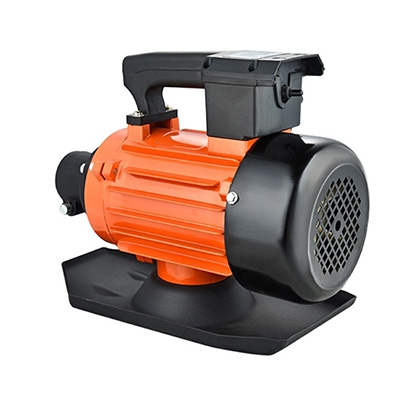How does a Concrete Vibrator Motor Work?
A concrete vibration motor is a kind of electric equipment widely used in concrete construction. Its working principle mainly involves vibration production generation, directional vibration, excitation force adjustment, automatic protection, energy saving and high efficiency, easy maintenance, long life, and low noise. Below is a detailed explanation of these aspects.
Working principle of concrete vibrator motor
Vibration generation: The core principle of the concrete vibration motor is to drive the eccentric block to rotate through the motor to generate centrifugal force and excitation force, thereby making the concrete dense and compact, eliminating phenomena such as honeycomb pitting of concrete, and improving strength. When the motor rotates, the inertia of the eccentric mass will cause the rotating shaft to produce periodic axial displacement, thereby generating a vibration force outside the motor.
Directional vibration: The design of the concrete vibration motor allows the direction of the vibration it generates to be controlled and adjusted. Through specific design and installation methods, the vibration energy generated by the motor can be effectively transmitted to the required construction parts, thereby improving the compactness and uniformity of the concrete.
Excitation force adjustment: The excitation force of the concrete vibration motor can be adjusted by changing the rotation speed or eccentric mass of the motor. In actual construction, the excitation force can be flexibly adjusted according to the required concrete type and construction conditions to achieve the best construction effect.
Automatic protection: Concrete vibration motors are usually equipped with overload protection and temperature protection functions to ensure that the motor can automatically protect itself under harsh working conditions and prevent damage due to overload or overheating.
Energy-saving and efficient: Modern concrete vibration motors usually use efficient motor designs and materials to improve work efficiency and reduce energy consumption. At the same time, its compact design also makes it more space-saving during construction.
Easy maintenance: Concrete vibration motors are usually designed to be easy to maintain and parts can be easily replaced. This greatly reduces usage costs and downtime and improves the overall reliability of the equipment.
Long life: High-quality materials and precise manufacturing processes give the concrete vibration motor a long service life. With proper maintenance, it can continue to work for many years, reducing the cost and frequency of equipment replacement.
Low noise: The concrete vibration motor produces low noise during operation, which not only improves the construction environment but also helps protect the hearing health of operators.
Main vibration transmission methods
Internal vibrator: This vibrator is installed directly in the mixing drum of the concrete mixer truck, and the motor drives the rotation of the internal shaft to generate vibration. The characteristic of the internal vibrator is that it acts directly on the concrete mixing materials to make the materials more evenly mixed.
External vibrator: This vibrator is installed outside the mixing drum of the concrete mixer truck. The motor drives the eccentric wheel to rotate to generate vibration, and then the vibration is transmitted to the mixing drum to make the concrete in the mixing drum more uniform.
Surface vibrator: This vibrator is installed directly on the surface of the concrete structure. The motor drives the eccentric to rotate and generate vibration, which makes the moisture and air on the surface of the concrete structure more discharged and enhances the compactness of the structure.
These vibration transmission methods all use the motor to drive the eccentric wheel to rotate to generate vibration and transmit the vibration to the concrete through different transmission methods to achieve the purpose of mixing or vibrating.
Working process of concrete vibration motor
Startup and operation: The starting process of the concrete vibration motor is similar to that of other motors. First, turn on the power supply. Start the motor and bring it up to operating speed. During the starting process, make sure that the motor is running normally without abnormal noise or vibration. Once the motor reaches operating speed, it can begin to transmit vibration energy to the concrete.
Vibration generation: The core function of the concrete vibration motor is to generate vibration. The vibration is generated by the eccentric mass installed inside the motor. When the machine rotates, the eccentric mass block will generate centrifugal force, which will produce periodic vibrations on the motor shaft. This vibration causes the concrete to flow and become dense through interaction with the concrete.
Directional vibration: Concrete vibration motors usually have the function of directional vibration, which means that they can control the direction of vibration. Through specific design and installation methods, the vibration energy generated by the motor can be effectively transmitted to the required construction parts, improving the compactness and uniformity of the concrete. Directional vibration helps ensure construction quality and efficiency.
Amplitude adjustment: The amplitude of the concrete vibration motor refers to the size or amplitude of the vibration. According to different construction requirements and concrete characteristics, the amplitude sometimes needs to be adjusted. By adjusting the input voltage or current of the motor, the centrifugal force of the eccentric mass can be changed, thereby adjusting the amplitude. Properly adjusting the amplitude can better meet construction requirements and improve the density of concrete.
Frequency adjustment: The frequency of a concrete vibration motor refers to the speed at which the motor rotates, expressed in revolutions per minute (RPM). Frequency adjustment is usually achieved by changing the input power to the motor. Different construction needs and concrete types may require different vibration frequencies. Appropriate frequency adjustment can improve construction efficiency and quality, making concrete more dense and uniform

